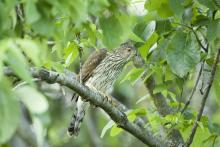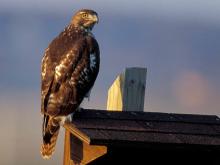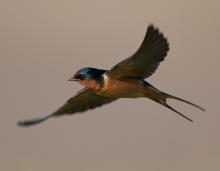Birds
Media

Species Types
Scientific Name
Accipiter striatus
Description
Sharp-shinned hawks flash out from trees and shrubs, surprising small birds and chasing them through the branches with great speed and accuracy.
Media

Species Types
Scientific Name
Accipiter cooperii
Description
Cooper's hawks have short, rounded wings and long, narrow, rudderlike tails. They are frequently seen foraging along hedgerows and brush-entangled fencerows.
Media

Species Types
Scientific Name
Buteo jamaicensis
Description
Adult red-tailed hawks are large, brown above, and white below, with a brown-streaked band on the belly and a rust-red tail with a narrow black band near the end. They are commonly seen along highways, watching for prey.
Media

Species Types
Scientific Name
Hirundo rustica
Description
Streamlined, agile fliers with forked tails, barn swallows build cup-shaped nests out of mud affixed to protected areas on the walls of barns and under bridges.
Media

Species Types
Scientific Name
Petrechelidon pyrrhonota
Description
Cliff swallows fly in swarms around their clusters of juglike mud nests attached to overpasses, bridges, and other structures. Note the whitish forehead, buffy rump patch, and chestnut throat.
Media

Species Types
Scientific Name
Gallinago delicata
Description
Wilson’s snipe, formerly called the common snipe, is a migratory game bird in Missouri. Like its relative the woodcock, this member of the sandpiper family is not usually seen on mudflats. It prefers swamps and wet, grassy areas.
Media

Species Types
Scientific Name
Spatula clypeata (formerly Anas clypeata)
Description
Northern shovelers are dabbling ducks with remarkably long, heavy-looking bills. The male’s green head may remind you of a mallard’s, but the bill is far heavier.
Media

Species Types
Scientific Name
Anas americana
Description
A common migrant in Missouri, the American wigeon is a dabbling duck whose males have a white forehead and crown, a green band behind the eye and down the back of the neck, and a large white patch on the wing.
Media

Species Types
Scientific Name
Anas strepera
Description
The male gadwall is a rather drab-looking duck with a black rear end and a white speculum (wing patch). This dabbling duck is a common migrant in Missouri.
Media

Species Types
Scientific Name
Anas crecca
Description
The green-winged teal is a fast, graceful flyer with an iridescent green wing patch. Teals are relatively small dabbling ducks and have been called the “bantams of the duck tribe.”
See Also







Media

Species Types
Scientific Name
Hemaris diffinis
Description
The snowberry clearwing is a moth that confuses people because it looks like a bumblebee and flies like a hummingbird!
Media

Species Types
Scientific Name
Hyles lineata
Description
The white-lined sphinx moth sometimes confuses people because it flies, hovers, and eats from flowers like a hummingbird. The adults often fly during daylight hours as well as in the night and are often found at lights.
Media

Species Types
Scientific Name
Darapsa myron
Description
The Virginia creeper sphinx moth is common in woods and brushy areas and comes to lights at night. The larvae eat Virginia creeper and grape leaves.
Media

Species Types
Scientific Name
Perimyotis subflavus (formerly Pipistrellus subflavus)
Description
Tri-colored bats, formerly called eastern pipistrelles, are relatively small and look pale yellowish or pale reddish brown. The main hairs are dark gray at the base, broadly banded with yellowish brown, and tipped with dark brown.
Media

Species Types
Scientific Name
Myotis grisescens
Description
Gray myotises are difficult to distinguish from other mouse-eared bats. A key identifying feature of the gray myotis is that its wing is attached to the ankle and not at the base of the toes. It’s an endangered species.
Media

Species Types
Scientific Name
Myotis lucifugus
Description
The little brown myotis (little brown bat) is one of our most common bats, but populations are declining. White-nose syndrome has taken a heavy toll in northeastern states. This species is now listed as vulnerable across its range.
Media

Species Types
Scientific Name
Myotis sodalis
Description
The Indiana myotis, or Indiana bat, summers along streams and rivers in north Missouri, raising its young under the bark of certain trees. It is an endangered species.
About Birds in Missouri
About 350 species of birds are likely to be seen in Missouri, though nearly 400 have been recorded within our borders. Most people know a bird when they see one — it has feathers, wings, and a bill. Birds are warm-blooded, and most species can fly. Many migrate hundreds or thousands of miles. Birds lay hard-shelled eggs (often in a nest), and the parents care for the young. Many communicate with songs and calls.





















